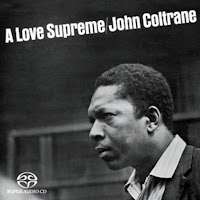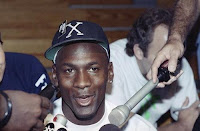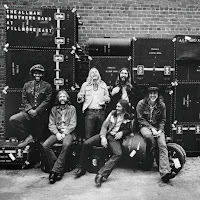John Coltrane, "A Love Supreme", released January 1965
It's my experience that people either really love jazz or really dislike jazz. I suppose I find myself somewhere in the middle . It's not my most favorite form of music but I always appreciate the musicians talents and their art of creating music. To me, listening to live jazz is an experience different than what you'll get at a rock/blues/country show. If you've never done that, I encourage anyone to seek it out, there's plenty of high quality jazz clubs in most large cities. But jazz can be a very difficult genre for a casual music listener. Certain jazz forms are more easily "digested" than others and the jazz featured on this album is of a form that even casual jazz listeners may struggle with comprehending.Coltrane was experimenting with forms of jazz that were in their infancy and being built upon by musicians like himself. This certainly isn't the jazz album you'll want to put on as background music to your evening meal. The album can be both melodic and jarring. At times soothing, at other times challenging. Coltrane was a most capable player. Incredible speed and rhythm but also taking turns at sheer maniacal wailing on his tenor saxophone. With smooth melodic chords and progressions being played beside loud arrhythmic drumming (timpani on a jazz record?) and odd piano phrasing accompanying it all and moving the music forward. It's a lot for the human ear to process. This is free form jazz at its birth. I try to imagine what was going on inside Coltrane's, and the other musicians, head as they formed these pieces. The use of mind altering drugs (particularly heroin) during this period of jazz is well documented; I believe that certainly had something to do with the experimentation and unique sounds they pieced together. It's evident why artist like Carlos Santana found influence in it's experimental approach. The talent on the other instruments is enormous with McCoy Tyner (piano) and Elvin Jones (drums) standing out in particular. Bass player Jimmy Garrison also does some unique, noteworthy soloing towards the end of track 3.
As someone who has attempted to play several musical instruments (bass clarinet, piano, & guitar), I definitely have a full appreciation and understanding of what it takes to make music. And to do it well is unique. To understand the way chords and progressions work is a mathematics of sorts. And no musical genre attempts to master the math like jazz musicians. All generations are trying to progress their musical genre but this era of jazz was it's most exploratory. Talents like Coltrane, Miles Davis, Thelonius Monk, Charlie Parker were attempting to take it in new and never before heard places. For the most part it works and you listen with amazement at what incredibly talented musicians these people were. The art they created was unique and progressive and in that way, it is critical and worthy of being considered one of the top 50 albums of all time.
More information on John Coltrane and the album:
https://en.wikipedia.org/wiki/A_Love_Supreme
https://en.wikipedia.org/wiki/John_Coltrane
Taxi Driver, released February 1976
"Are you talking to me? You talking to me?" This scene from the movie, "Taxi Driver" has become absolutely iconic, with most people not even aware of where it came from within popular culture. This is a pretty dark movie with serious anti-hero overtones and psychotic level behaviors. This film does feature early work from several actors that have each gone on to very successful Hollywood careers including: Robert DeNiro, Cybill Shepherd, Jodie Foster, Harvey Keitel, and Albert Brooks. This is also one of the first feature films from legendary director Martin Scorsese.I'd seen this movie in the past but didn't remember all the scenes. It was much more graphic than what I remembered, both in terms of language, content and visual effects. Of course, DeNiro played his role so perfectly and he really inhabits the multilayered Travis Bickle character. He uses a technique called method acting and apparently worked as an actual taxi driver in preparation for this movie. Commitment to a role has never been his weakness. Cybill Shepherd, at age 26, has so much charisma and sex appeal on camera and the chemistry between her and DeNiro feels very real. A fourteen year old Jodie Foster has the acting chops of someone 3 times her age. I watched a behind the scenes on this movie where Jodie Foster said her mother was called to bring her in to audition for a role (an underage prostitute) and upon walking in they were certain she was perfect for the role. I can't imagine having a child as a working actor and signing off on letting her play a street walker. According to the movie's Wikipedia entry, the producers made her see a psychologist regularly to ensure that they weren't doing any long term damage to her young, impressionable brain. Now THAT'S commitment to getting and keeping an acting role!
I also enjoyed the soundtrack and score of this movie. It was done by Bernard Hermann, who also scored movies such as Citizen Kane (#1 movie of all time according to AFI), Vertigo, Psycho, North By Northwest (Hitchcock), and many others. There is also a sequence in the middle where a pop song is played. It's a song by Jackson Browne called "Late for the Sky". Music has always been a big piece of all Scorsese movies, almost like a character of sorts. He also directed what most regard as the finest live action music movie called "The Last Waltz" about The Band's last concert. He also directed the Bob Dylan documentary, "No Direction Home" and Michael Jackson's video for the song "Bad". Clearly, music is important to Scorsese and this film definitely sets a mood using the music.
I believe this movie is definitely one worth seeing at least once. It's great to see DeNiro and Scorsese becoming one of the greatest actors/directors of their generation and arguably of all time.
https://en.wikipedia.org/wiki/Taxi_Driver
https://www.youtube.com/watch?v=lQkpes3dgzg "Are you talking to me??"
https://www.youtube.com/watch?v=kqYiHkx7ils "Late for the Sky", Jackson Browne
Next week, #46
Bob Marley, "Legend"A Clockwork Orange




















